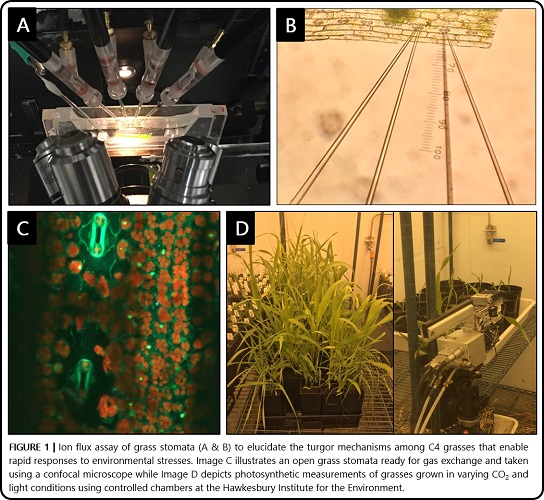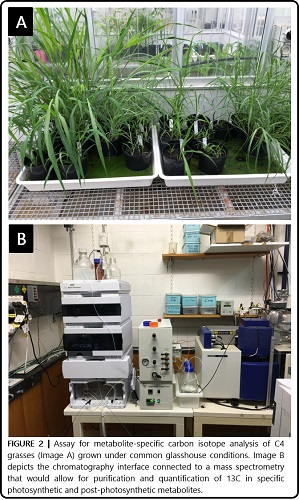Doctor Walter Israel
Candidature
Graduate PhD 2021
Thesis Title
Carbon isotope discrimination and stomatal function in C4 grasses
Research Project
 Water scarcity is a perennial dilemma which is projected to intensify over the next fifty years due to an increasing population, frequent droughts associated with climate change, and water mismanagement. Globally, 80-90% of water is used in agriculture [4] and in Australia, 75% of agricultural water usage is allocated towards irrigation. However, water resources such as river basins and groundwater are nearing/exceeding their extractable limits [5] leading to major impacts on crop yield, resulting in a world food crisis. To alleviate this crisis, we need to improve crop resiliency to drought and this can be achieved by improving water-use efficiency (WUE).
Water scarcity is a perennial dilemma which is projected to intensify over the next fifty years due to an increasing population, frequent droughts associated with climate change, and water mismanagement. Globally, 80-90% of water is used in agriculture [4] and in Australia, 75% of agricultural water usage is allocated towards irrigation. However, water resources such as river basins and groundwater are nearing/exceeding their extractable limits [5] leading to major impacts on crop yield, resulting in a world food crisis. To alleviate this crisis, we need to improve crop resiliency to drought and this can be achieved by improving water-use efficiency (WUE).
Grasses account for the majority of food production throughout the world and also dominate the semi-arid and canopy understory of Australia. Almost 47% of the grass species assimilate CO2 from the atmosphere using C4 photosynthesis [7], a variant of the common C3 photosynthesis. C4 plants use a carbon concentrating mechanism (CCM) which enables them to achieve higher CO2 fixation per unit of water loss translating to better WUE than their C3 counterparts, mainly because it enables them to suppress a wasteful process called photorespiration [6]. Amongst grasses, rapid stomatal response to water limitation is an additional factor that has contributed to their success and productivity [1]. Therefore, C4 photosynthesis and advanced stomatal control within grasses is an imperative combination to pursue for the optimisation of leaf WUE.
The major substrate of photosynthesis (CO2) exists in two stable isotopes (13CO2 and 12CO2) each with slight difference in atomic mass and abundance, with the former being heavier and scarcer. Breeding crops with improved WUE has been successful by examining the integrated ratio (13C/12C) of the two naturally occurring stable isotopes of carbon incorporated during photosynthesis [3]. This technique has provided high throughput selection of wheat (a C3 grass) varieties with improved WUE, namely “Drysdale” and “Rees”, and are now used commercially in Australia [2]. While this method is straightforward among C3 grasses, CCM within C4 grasses makes it difficult to implement. Thus, examining the isotope signatures (13C/12C) of major leaf metabolites could give insights into the fluxes of 13C within the C4 CCM, and ultimately aid the understanding of WUE mechanisms among C4 grasses.
The goals of my PhD project are to (1) better understand the link between stomatal responses and leaf WUE by exploring the physiological mechanisms underpinning highly responsive C4 grass stomata, particularly species native to Australia; and (2) investigate the role of 13CO2 and its redistribution in C4 leaf biochemical processes during and after photosynthesis.
The outcomes of my PhD will provide critical knowledge elucidating stomatal regulation of grasses and biochemical controls of carbon fluxes within the C4 leaves, allowing for the development of screening tools for breeding crops with improved WUE.
__________________________________________________
*References
[1] Chen Z-H, Chen G, Dai F, Wang Y, Hills A, Ruan, Y-L, Zhang G, Franks PJ, Nevo E, Blatt MR (2016). Molecular Evolution of Grass Stomata. Trends in Plant Science, 2: 124–139. http://doi.org/10.1016/j.tplants.2016.09.005
[2] Condon AG, Richards RA, Rebetzke GJ, and Farquhar GD. (2004). Breeding for high water-use efficiency. Journal of Experimental Botany, 55(407), 2447–2460. http://doi.org/10.1093/jxb/erh277
[3] Farquhar GD, and Richards RA. (1984). Isotopic composition of plant carbon correlates with water-use efficiency of wheat genotypes. Australian Journal of Plant Physiology, 11(6), 539–552. http://doi.org/10.1071/PP9840539.
[4] Morison JI, Baker NR, Mullineaux PM, & Davies WJ. (2008). Improving water use in crop production. Philosophical Transactions of the Royal Society B, 363(1491), 639–658. http://doi.org/10.1098/rstb.2007.2175
[5] National Land and Water Resources Audit (2008). Australian Water Resources Assesment 2002-2008. 175 pp.
[6] Sage RF (2004). The evolution of C4 photosynthesis. New Phytologist, 161 (2), 341–370. http://doi.org/10.1046/j.1469-8137.2004.00974.x
[7] Sage RF, Li M, Monson RK (1999) The taxonomic distribution of C4 photosynthesis. In ‘The biology of C4 plants’. (Eds RF Sage and RK Monson) pp. 551–584. (Academic Press: San Diego)
Research Images


Publications
Israel WK, Watson-Lazowski A, Chen Z-H, Ghannoum O, (2022) 'High intrinsic water use efficiency is underpinned by high stomatal aperture and guard cell potassium flux in C3and C4grasses grown at glacial CO2 and low light', Journal of Experimental Botany, vol.73, no.5, pp 1546 - 1565
Lin H, Karki S, Coe RA, Bagha S, Khoshravesh R, Balahadia CP, Sagun JV, Tapia R, Israel WK, Montecillo F, de Luna A, Danila FR, Lazaro A, Realubit CM, Acoba MG, Sage TL, von Caemmerer S, Furbank R, Cousins AB, Hibberd JM, Quick WP, Covshoff S. (2016). Targeted Knockdown of GDCH in Rice Leads to a Photorespiratory-Deficient Phenotype Useful as a Building Block for C4 Rice. Plant and Cell Physiology, 57(5), 919–932. http://doi.org/10.1093/pcp/pcw033
Supervisors
Assoc. Professor Oula Ghannoum (HIE-WSU), Assoc. Professor Zhong-Hua Chen (SSH-WSU), Dr. Hilary Suart-Williams (RSB-ANU)